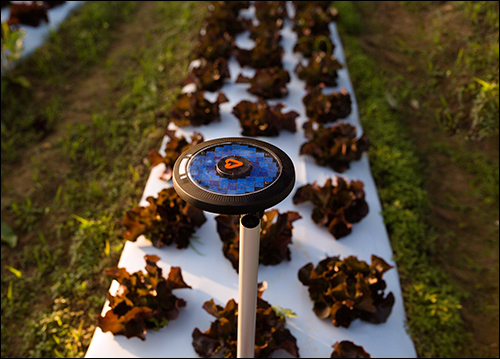Adam Wolf has been frustrated with sensor networks used to monitor farmland since he was a graduate student at UC Davis, 20 years ago. “I was an agronomist and have used this sort of equipment to do research,” he says, “but by the time I finished grad school, I realized I hated this stuff.”
Wolf recalls having to pull together all of the elements needed to conduct a research project, only to be disappointed with the results. “[There were] disparate sensors, with bare wires,” he says. “You’d need to connect to a data logger that you’d program using an archaic language.” This might all be powered by a car battery, charged by a solar panel. What’s more, there were no telematics components, so the data would be collected onsite and remain there. “You’d show up six months later and realize it had stopped working a week after you left, or it was vandalized, or the battery stopped working.”
Wolf went on to receive his Ph.D. degree from Stanford, where he studied remote sensing, as well as land and surface modeling, followed by postdoctoral work at Princeton University. In 2010, he partnered with Kelly Caylor, an associate professor in Princeton’s department of civil and environmental engineering, to develop a sensor that could surmount the many usability hurdles Wolf had experienced with early remote sensors systems. “We’re numbers people, trying to use data for something useful, and got hung up on the obstacle of collecting data, when the goal is really to do something for research or for business value,” Wolf says, by way of explaining what inspired him and Caylor to develop their own sensors.
At the time, Wolf was studying forest physiology, but many of the same needs he’d had when focused on agriculture applied to sensors as well. Caylor, meanwhile, sought a system that could be used to assist subsistence farmers in sub-Sahara Africa.
Their collaboration evolved into an academic lab called Pulselab, and the initial sensor unit they developed was dubbed the Pulsepod. The duo decided to commercialize the device by means of a standalone company, Arable, which has raised $1.5 million to fund its initial product launch. This week, Arable announced that the latest version of the Pulsepod is commercially available.
The disc-shaped device runs on a battery that is recharged by solar power. It contains a six-band spectrometer, which is used to track water and chlorophyll content in a plant’s leaves by measuring the amount of sunlight they absorb, as well as a four-way net radiometer and an acoustic rain gauge to track rainfall. (A net radiometer measures the difference between incoming solar radiation and outgoing [reflected] solar radiation.) The Pulsepod also includes a thermistor, air pressure and humidity sensors, and a port for an auxiliary sensor that could accommodate a moisture sensor, or a sensor to track water pressure in a linked irrigation system.
“The biggest invention is the rain gauge,” Wolf states, “[because] it measures each drop, while most of the world uses radar to measure rainfall—which is, for the most part, not calibrated” to specific areas within a field. And because rainfall can vary across a given field, he notes, the gauge can help farmers to understand water needs with more precision.
For connectivity, the Pulsepod uses a cellular (2G/3G) modem, but it also contains Wi-Fi and Bluetooth radios that can be used to transmit data to a Wi-Fi gateway or mobile device. Each device also contains a GPS receiver.
Arable makes the data available via an application programming interface so that it can be brought into existing platforms like AgSense or AgWorld. Conversely, a user can download the data into a Microsoft Excel spreadsheet.
The device, which can be mounted on a stake low to the ground, on a center pivot irrigation machine or on a pole, sells for $500. This price includes cellular subscription costs throughout the life of the product.
Arable has attracted a long list of beta-testers that have agreed to evaluate the Pulsepod, including labs in a number of federal agencies, such as the U.S. Department of Energy, the National Oceanic and Atmospheric Administration and NASA’s Jet Propulsion Laboratory; researchers at Stanford University and Lawrence Berkeley National Laboratory; and various non-governmental organizations. A few commercial agricultural producers, including the Francis Ford Coppola Winery, berry grower Driscoll’s and U.K. feed producer AB Agri, have agreed to run pilot programs to test the Pulsepod and determine whether they can use the data it produces to directly improve their operations.
Steve LeRoux, AB Agri’s head of product innovation, says the agriculture industry is in dire need of precise, affordable technology that can help companies improve yield while reducing costs as population growth puts increasing pressure on producers. “You see gizmos at [agricultural] trade shows,” he states, “but agriculture is so far behind other sectors [when it comes to IoT technology] and we have a huge catch-up to do.”


